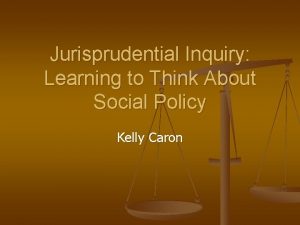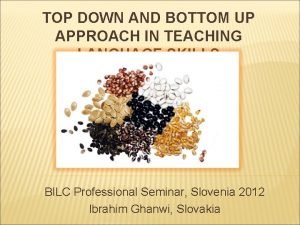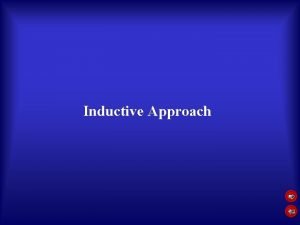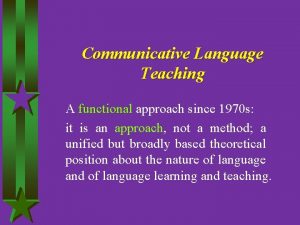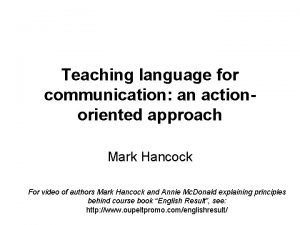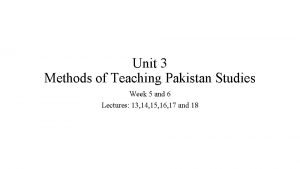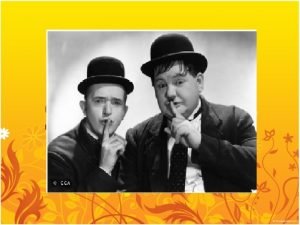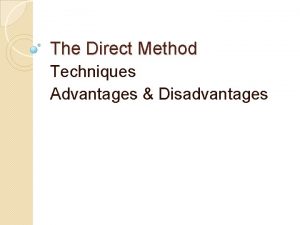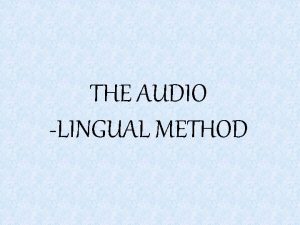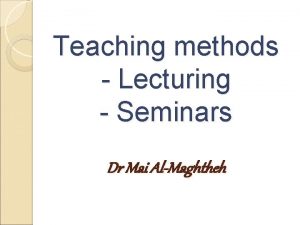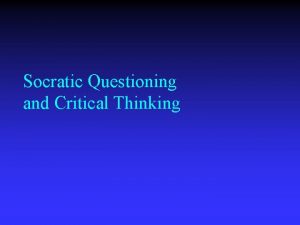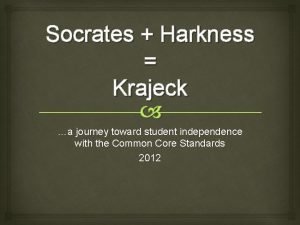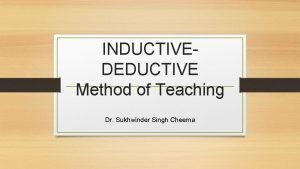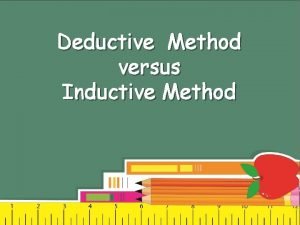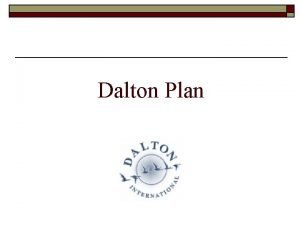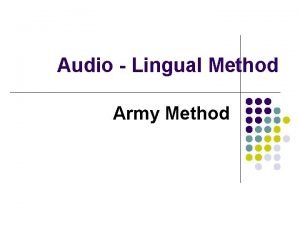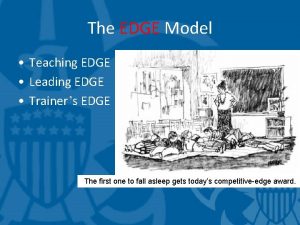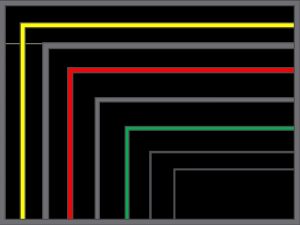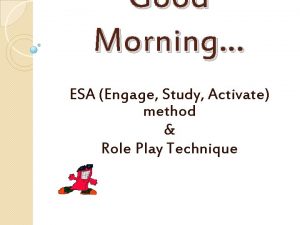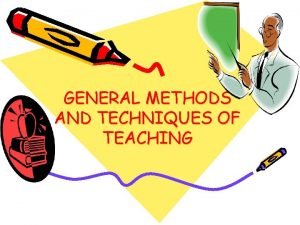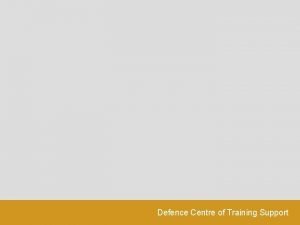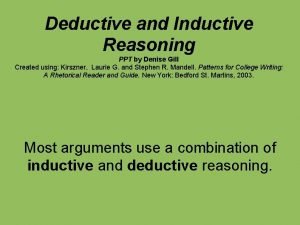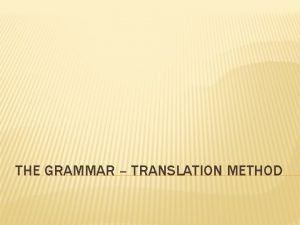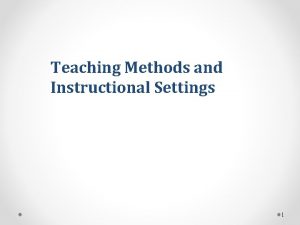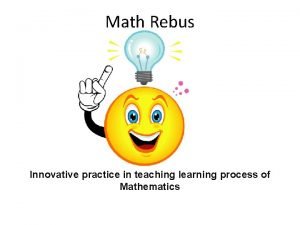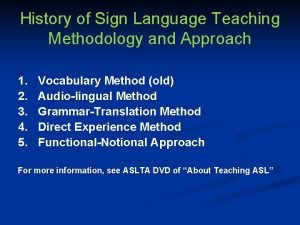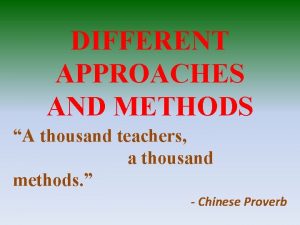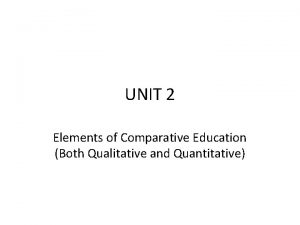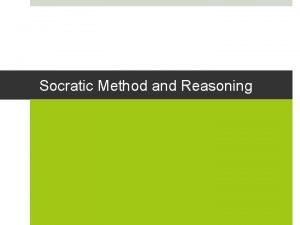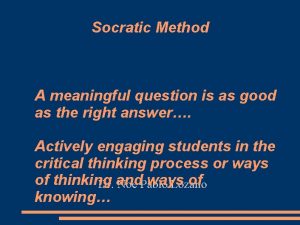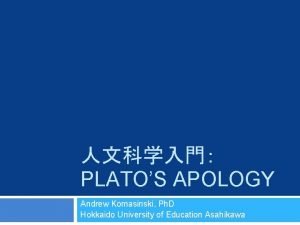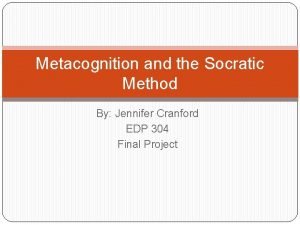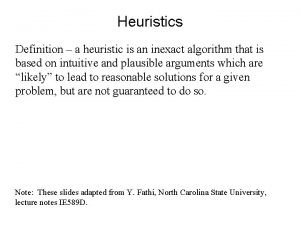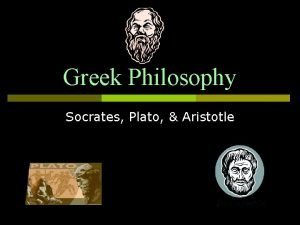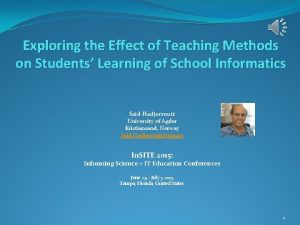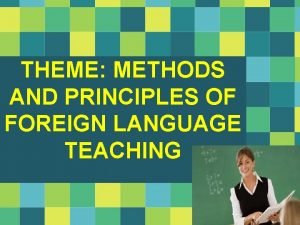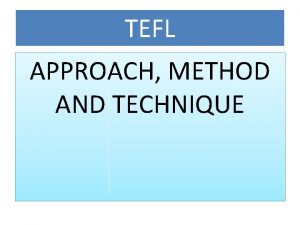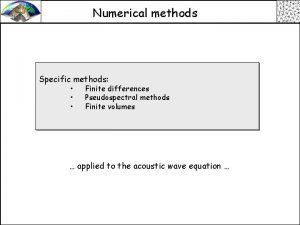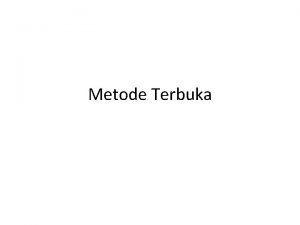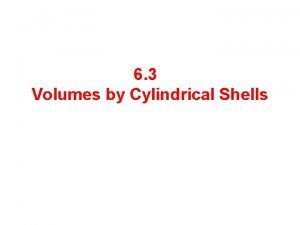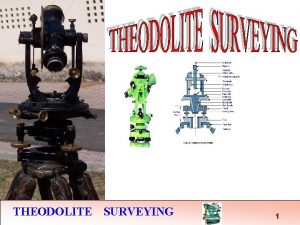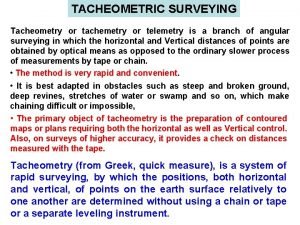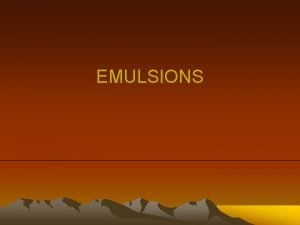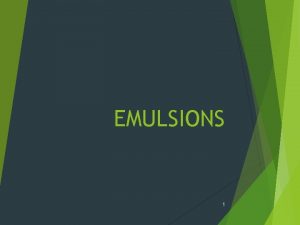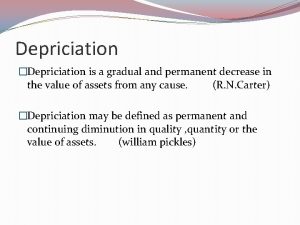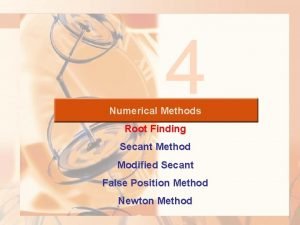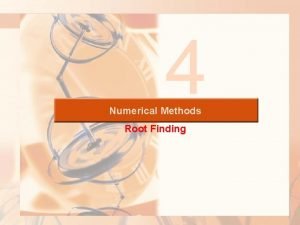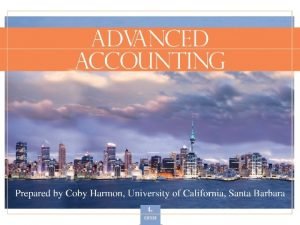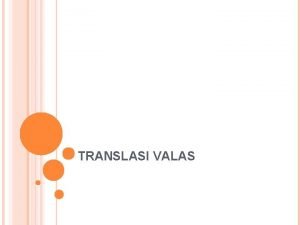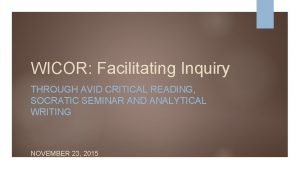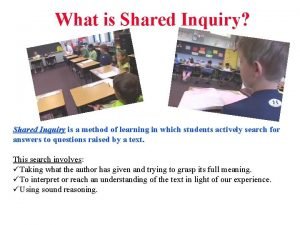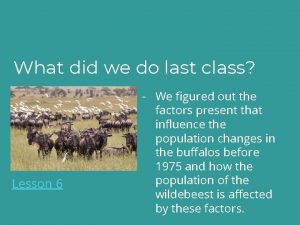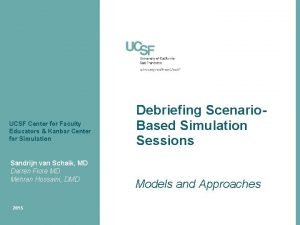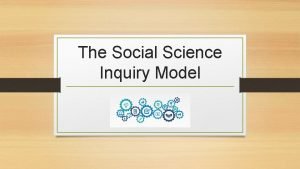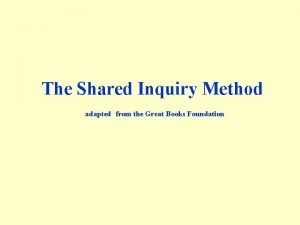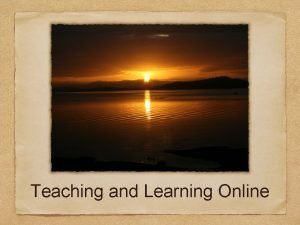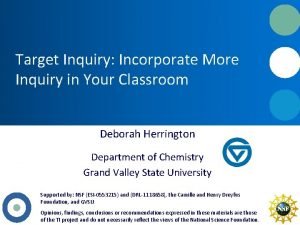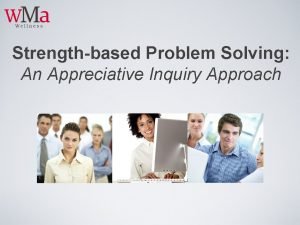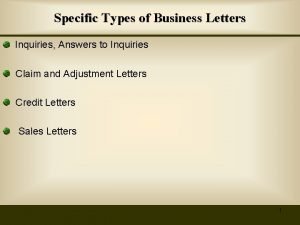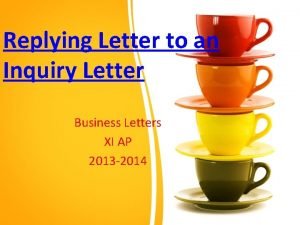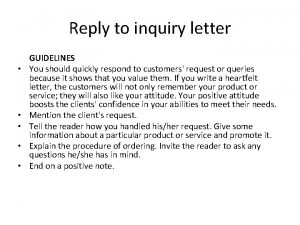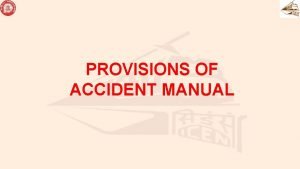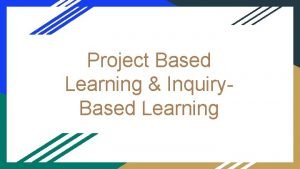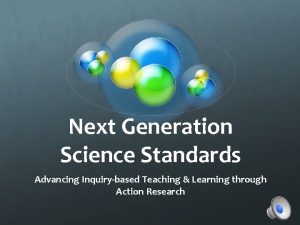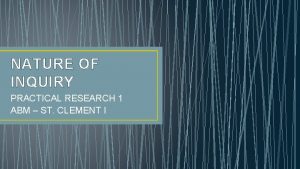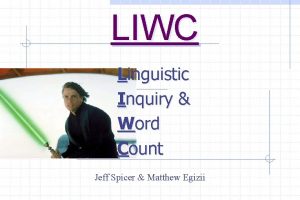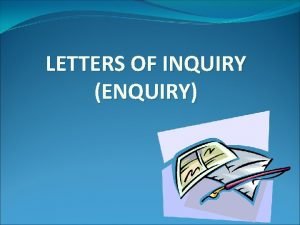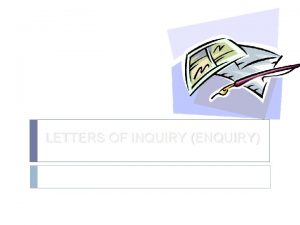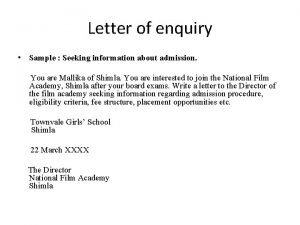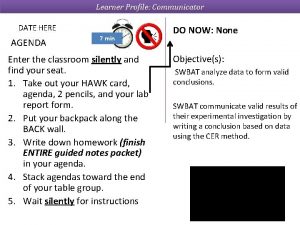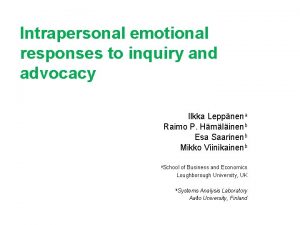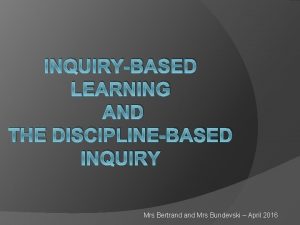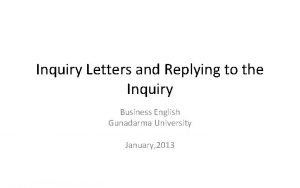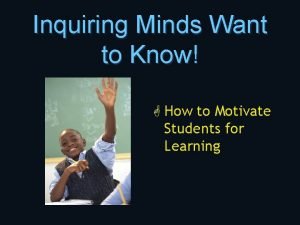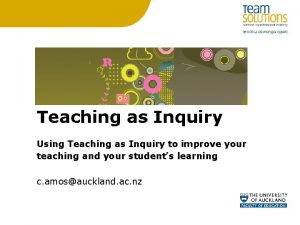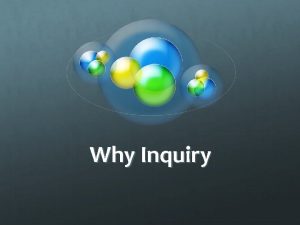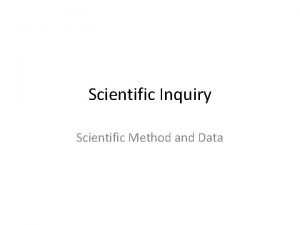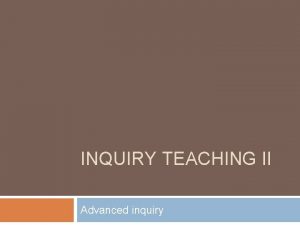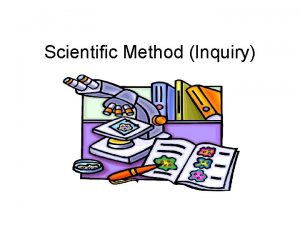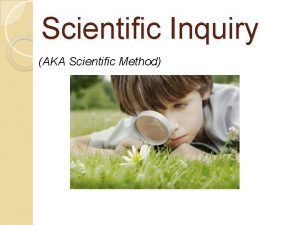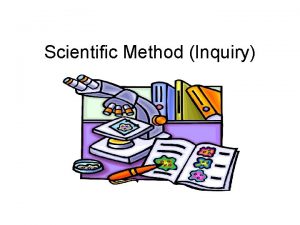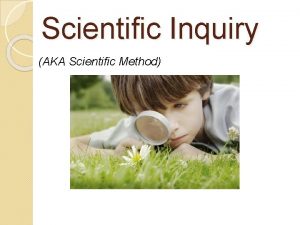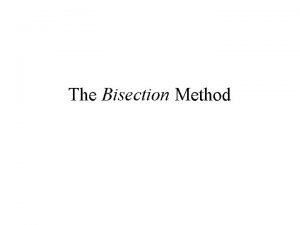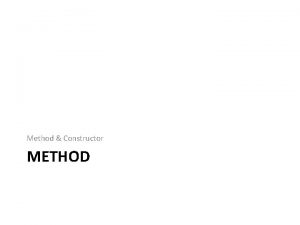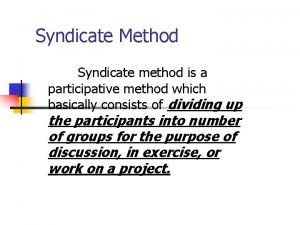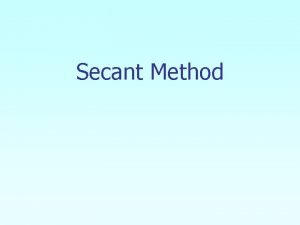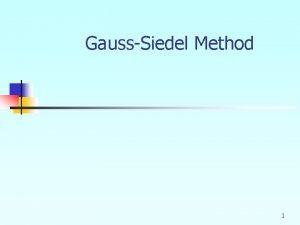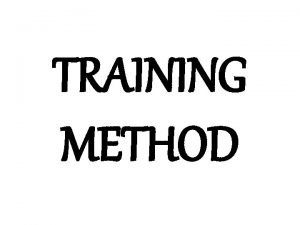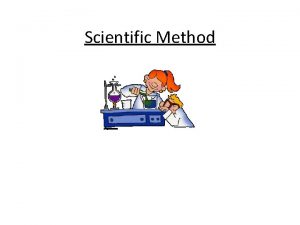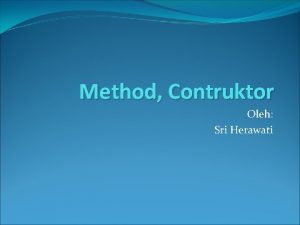inquiry Approach of teaching Inquiry method It is



















































































































- Slides: 115

inquiry Approach of teaching

Inquiry method It is a student-centered method of education focused on asking questions. Students are encouraged to ask questions which are meaningful to them, and which do not necessarily have easy answers; teachers are encouraged to avoid giving answers when this is possible, and in any case to avoid giving direct answers in favor of asking more questions. In this way it is similar in some respects to the Socratic method. The method was advocated by Neil Postman and Charles

Definition of Inquiry “Inquiry” is defined as a quest “for truth, information, or knowledge…seeking information by questioning”. Individuals go through a process of inquiry from birth until they die. Babies begin to make sense of their surrounding through their curious observations. The process of inquiry begins with “…constructing and gathering information and data through applying the human senses”.

Foundations of Inquiry It is based on constructivist learning theory. Learning is enhanced through the inquirers‟ opportunity to engage in real life activities, situations and with real audience. From theory teachers generate the facts that students: • Can actively build their knowledge and understanding through their inquiries and information - seeking nature. • Develop their cognition as well as meta cognition as they absorb the information. • Experience changes in their affective and cognitive domains as they progress. • Need time to reflect on their new - found knowledge and process the information.

WHY INQUIRY? • Tell me and I forget, show me and I remember, involve me and I understand. • Inquiry implies involvement that leads to understanding.

Types of Inquiry • Inquiry-based instruction involves creating situations in which students take the role of scientists. These types of learning situations typically occur along a continuum. Directed Inquiry Students follow precise teacher ←→ instructions to complete a hands-on activity. Guided Inquiry Open Inquiry Students generate develop the questions about a procedure to teacher-selected ←→ topic and design investigate a their own teacher-selected investigations. question.

Inquiry Model An inquiry model provides a clear picture to the roles of the educators and learners pertaining to the concept. In this model 7 phases are involved: reflecting, planning, retrieving, processing, creating, sharing and evaluating.


Planning Phase At this initial phase students will experience a sense of interest in or curiosity about the topic. Students will start by: • Figuring out the general questions that need to be investigated. • Finding the information and materials regarding the particular topic. • Determining the way to present the information to the target audience. • Suggesting the criteria pertinent to their research product and process evaluation.

Retrieving Phase • Students may not know how to determine which info is irrelevant or which is related to their inquiry and may get frustrated. Here is where the role of teacherfacilitator comes in. Teacher must guide them and provide them the correct skills and strategies to determine relevant information. • After information inquirers now students need to come to a focus for their topic.

Processing Phase Now that the inquirers have decided on their “focus‟ they will be able to decide on their specific objective and is able to come up with their statement But may be confused. Therefore, facilitators must guide learners how to compare, contrast and synthesize data in order to obtain the right resources

Creating Phase At this phase the inquirers have a certain amount of readiness and are able to organize the information as well as create a presentation format but may be quite uncertain of their product and need teachers’ guidelines in producing the acceptable one. Teacher may also encourage cooperative and collaborative activities among the learners whereby they can be teamed up in their creative efforts and come up with the relevant resources, discussions and on-line projects.

Sharing Phase • This is the stage where inquirers will learn to communicate and share their new understanding in a variety of ways with their target audience such as through project presentations. Student inquirers will also learn to develop positive feedback and questioning techniques. • At this instant, collaborative effort will be demonstrated at the time where the inquirers support the other members in their sharing by participating as audience members. It is better to have inexperienced or novice researchers to be involved in small group sharing rather than having each individual student share their work with the whole class as it is often more successful and time –efficient

Evaluating Phase In order to reach successful outcomes in inquiry, the instructor must provide the inquirers with opportunities to reflect on the original brainstorming session and examine the development of their focus. It is essential that the inquirers make use of learning tools such as rubrics and checklists to evaluate their products and processes. Inquirers are also encouraged to work collaboratively at this stage to edit each other’s product.

INQUIRY LEVELS Level 1: Confirmation Inquiry The teacher has taught a particular science theme or topic. The teacher then develops questions and a procedure that guides students through an activity where the results are already known. This method is great to reinforce concepts taught and to introduce students into learning to follow procedures, collect and record data correctly and to confirm and deepen understandings.

Level 2: Structured Inquiry • The teacher provides the initial question and an outline of the procedure. • Students are to formulate explanations of their findings through evaluating and analyzing the data that they collect.

Level 3: Guided Inquiry • The teacher provides only the research question for the students. • The students are responsible for designing and following their own procedures to test that question and then communicate their results and findings.

Level 4: Open/True Inquiry Students formulate their own research question(s), design and follow through with a developed procedure, and communicate their findings and results. This type of inquiry is often seen in science fair contexts where students drive their own investigative questions.

Advantages of Inquiry • Learners direct their learning in a way that is similar to how science happens in real-world situations. • Students are able to identify their own areas of inquiry and engage in hands-on learning using science process skills to seek information. • This results in increased ownership of learning and enhanced critical thinking skills while creating a culture that values learners’ ideas.

Teacher’s Role • Reflect on the purpose and makes plans for inquiry learning. • Facilitate classroom learning. • Serve primarily as a resource for the students. • Guide the students through the learning process. • Establish content-based parameters for learning objectives, and then allow students to direct their own learning. • A co-learner with the students as they engage with real-world questions. • Provoke additional inquiry of the questions presented by the student.

Characteristics of Teachers for inquiry teachers have the following characteristics • They avoid telling students what they "ought to know". • They talk to students mostly by questioning, and especially by asking divergent questions. (with no specific answer, but rather exercises one's ability to think broadly) • They do not accept short, simple answers to questions. • They encourage students to interact directly with one another, and avoid judging what is said in student interactions. • They do not summarize students' discussion. • They do not plan the exact direction of their lessons in advance, and allow it to develop in response to students' interests. • Their lessons pose problems to students. • They gauge their success by change in students' inquiry behaviors

LEARNER’S ROLE • View themselves as learners in the process of learning. • Accept an "invitation to learn" and willingly engage in an exploration process. • Raise questions, propose explanations, and use observations. • Plan and carry out learning activities. • Communicate using a variety of methods. • Critique their learning practices. • Direct their own learning within the parameters set by the facilitator. • Work in groups and learn from each other.

INQUIRY CHALLENGES • Time-Consuming – More intense learning process • Messy – More authentic replication of real-world situations • Loud and Chaotic – Students are more engaged • Unpredictable – More meaningful teachable moments

Summary • Inquiry learning involves developing questions, making observations, doing research to find out what information is already recorded, • developing methods for experiments, • developing instruments for data collection, collecting, analyzing, and interpreting data, outlining possible explanations and • creating predictions for future study.

Exploratory Approach in Teaching

Exploratory Approach in Teaching • “A process that leads to change, which occurs as a result of experience and increases the potential of improved performance and future learning”

Human brain is immensely complex and still somewhat of a mystery. Learning is a primary function of brain. Thus learning is the acquisition of knowledge or skills through study, experience, or being taught. The ability to learn possessed by humans, animals and some machines. In the context of classroom teaching and learning is very important processes. There are various methods and techniques used to learn and teach more effectively. Exploratory learning is an important technique in the idea of constructivism.

Exploratory teaching is a relatively new approach to education that places an emphasis on more student involvement in the classroom. It is a student centred pedagogy. It encourages students to think creatively, experience key concepts and learn how to reflect on what they learn.

• An approach to teaching and training that encourages the learner to explore and experiment to uncover relationship, with much less of a focus on didactic training. • Exploratory teaching does not necessarily mean an unguided or unconstrained learning environment, but does mean that leaners may discover unexpected lessons and reach conclusions following various paths.

• Exploratory teaching approaches are considered most appropriate for teaching generalized thinking and problem solving skills and may not be the best approach for such things as memorization. • Exploratory learning familiarly known as out of the box thinking. Innovative thinking, creativity and exploration are the key elements of the learner’s experience of the designs.

Three Fold Exploratory Teaching • The power of exploratory teaching is three fold. i. Exploration is very effective at uncovering for new ideas, innovative connections and expensive ranges of high value possibilities. ii. These processes over time allow learners to build and implement wide ranging exploratorydiscovery capabilities. iii. Exploratory learning design may support substantial shifts in perspectives, core assumptions and shift the learner away from habitual and conditioned approaches.

Exploratory teaching process • Exploratory teaching processes may be specifically targeted to reward the learner with exciting insights about a broad range of professional and personal challenges. Generally, these potential targets fall into one of two categories. • First is the category for which new ways of looking at a challenge, and an increase in opportunities, is likely to be very valuable. • Second is the category for which a significant shift away from the habitual, routine and tried-andtrue perspectives is found to be very valuable.

At the end of the processes • At the end of the processes, the realisation value of some sort is paramount. • Exploratory learning excels at supporting high value outcomes because a crucial intrinsic feature of the process is reflective evaluation. • Exploratory learning is a very strong aid to learning more about what purpose drives the learner. Likewise, the processes can support powerful investigations into what are possible richest, most powerful values, visions, and missions of the learner.

• Collaborative applications make possible rich experiences of interdisciplinary and interpersonal problem solving, team creativity and team innovation. Many people think that it may very hard. • At first, because the applications are designed to separate learners from routine approaches, exploratory teaching may seem unfamiliar, may be a little foreign and strange. • Yet, because the processes implement a form of play and because they are directed at uncovering valuable possibilities rather than singular answers.

CHARACTERISTICS OF EXPLORATORY LEARNING • Open ended process. • Out of box thinking. • Develop innovative and creative thinking. • Reflective Evaluation. • Aimed at transformation. • Exciting Insights. • Shift learner from habitual and conditional approaches.

WHY THE EXPLORATORY TEACHING IS MORE EFFECTIVE Exploratory teaching will be a more effective for learning. Because • cognitive development is limited to a certain range at any given age. • The exploratory learning will enhance the student’s achievement. • Exploratory learning provide opportunities for social interaction. As full cognitive development requires social interaction. Hence it is fruitful strategy of learning.

Principles of Exploratory Approach to Teacher Development

Principle One • The goal of exploration is to see teaching differently: To accomplish this we need to be willing to explore by making small changes to our teaching. • Through exploring to see teaching differently by trying out new behaviors in teaching.

Through exploring to see teaching differently by trying out new behaviors to see what happens affords us chances to “construct, reconstruct, and revise our teaching” (Fanselow, 1988, p. 116). When we try new things, we can compare them with what we usually do, and based on this comparison we can see our teaching differently, including our beliefs about teaching and learning. By aiming to see our teaching differently, we want to discover new things about ourselves and consider our teaching beliefs and practices.

Principle Two • To explore teaching, we need to accept responsibility for our own teaching, but we also know that we need others to explore.

Actually as a teacher, only I can really understand what I am trying to do in class, how it works out for me, and what I learn from it. As teachers we need to take responsibility as to what we want to see going on in the classroom. By cooperating with others, we can come to understand our own experience and opinions. Fanselow (1997) says this in a different way: Seeking to explore by ourselves, alone, “is like trying to use a pair of scissors with only one blade”

Principle Three: Prescriptions can limit exploration Prescription is to follow some set method given the books or told by the teachers. Which is not good for effectiveness because of individual differences, situation outside of the classroom, social environment, gadgets in use etc? So there is always need to explore the new ways of teaching.

Principle Four: Exploration is enhanced through description. Descriptions can then be studied, and based on these descriptions we can think about our teaching and generate alternative ways to teach. Descriptions provide a mirror image that we can use to reflect on teaching. In short, it is through descriptions, more than prescriptions, we can gain deeper awareness of our teaching and to see our teaching differently.

Principle Five: Exploration is enhanced when we take a non-judgmental stance. Judgment positive or negative, our own or others’, can raise emotions which can interfere with a focus on description.

Principle Six: Reflection is a part of exploration. Reflective teaching includes “collecting data about teaching, examining their attitudes, beliefs, assumptions, and teaching practices, and use the information obtained as a basis for critical analysis”. More we explore, and the more we are able to see our teaching differently, the more we gain in our abilities to reflect-in-action and reflect-on-action. When we look at their work in the moment (reflectin-action) or in retrospect (reflect-on-action) in order to examine the reasons and beliefs underlying their actions and generate alternative actions for the future.

Principle Seven: To see teaching differently, we need to go beyond trying to solve problems in our teaching; we can do this by taking different avenues to awareness. Exploration of teaching includes the use of avenues to awareness. The most travelled avenue is that of problem solving. However, by only focusing on trying to work out problems, we miss chances to see teaching outside of these problems.

Although problem solving makes sense and is certainly worth doing, we can go beyond looking for solutions to problems by taking a variety of other avenues to awareness. One of these avenues is to explore simply to see what happens. For example, If we usually have students sit in rows, we can have them form a semicircle. If we always teach from the front of the classroom, we can try teaching from the back. If students read aloud in every class, we can ask them to read silently. The idea is to discover what we normally do and to try the opposite to see what happens. • One way to do this is exploring what we actually do in our teaching as opposed to what we think we are doing.

Experiment

Experiment An experiment is a procedure carried out to support, refute, or validate a hypothesis. Experiments provide insight into cause-and-effect by demonstrating what outcome occurs when a particular factor is manipulated. Experiments vary greatly in goal and scale, but always rely on repeatable procedure and logical analysis of the results.

• Experiments typically include controls, which are designed to minimize the effects of variables other than the single independent variable. • if all controls work as expected then concluded that results are due to the effect of the tested variable. • Experiments in the modern sense is visible in the works of the Arab mathematician and scholar Ibn al. Haytham in the field of optics

• Francis Bacon (1561– 1626), an English philosopher and scientist became an influential supporter of experimental science • A comparison of earlier results with the experimental results is necessary for an objective experiment.

Classroom Experiments and other types of hands-on activities are very important to student learning in the science classroom. Experiments can raise test scores and help a student become more engaged and interested in the material they are learning, especially when used over time.

Types of Experiment 1. In some disciplines (e. g. , psychology or political science), a 'true experiment' is a method of social research in which there are two kinds of variables. The independent variable is manipulated by the experimenter, and the dependent variable is measured. The signifying characteristic of a true experiment is that it randomly allocates the subjects to neutralize experimenter bias

Controlled experiments • A controlled experiment often compares the results obtained from experimental samples against control samples, which are practically identical to the experimental sample except for the one aspect whose effect is being tested (the independent variable). A good example would be a drug trial.

Natural experiments are also called quasiexperiments. Natural experiments rely solely on observations of the variables of the system under study, rather than manipulation of just one or a few variables as occurs in controlled experiments. It depends on the observed correlation between explanatory variables in the observed data. Much research in several science disciplines, including economics, political science, geology, paleontology, ecology, meteorology, and astronomy, relies on quasi-experiments.

Field experiments • Often used in the social sciences, and especially in economic analyses of education and health interventions, field experiments have the advantage that outcomes are observed in a natural setting rather than in a contrived laboratory environment.

Classroom Experiments Classroom experiments are activities where any number of students work in groups on carefully designed guided inquiry questions. Materials provide students with the means of collecting data through interaction with typical laboratory materials, data simulation tools or a decision making environment, as well a series of questions that lead to discovery based learning.

• During the experiment itself the students and/or instructor collect data or observations. However, the most critical role for the instructor is to act as facilitator, asking leading questions and drawing attention to interesting results. A well-designed experiment targets common student misconceptions, focusing on major ideas that students will need to understand correctly in order to support deep learning.

• Classroom experiments help students learn more about the material they are studying. • In this case, the hypothesis to be tested will generally be derived from material contained in a textbook or other course materials.

Goals of classroom experiments • Some possible goals of classroom experiments/labs are that students participate in include: • Discovering existing scientific concepts • Elicit misconceptions Formulating questions Involving students in the design of experiments Creating and revising models Understanding the relationship between empirical research and models • Learning how scientific studies are conducted • •

Teaching Pedagogies for experiment • Cooperative Learning: Students participating in Cooperative Learning exercises might be doing an experiment, however there a number of other possible tasks. Some Classroom Experiments are Cooperative Learning exercises wherein others students work independently during the experiment.

Data Simulations • Data Simulations use physical materials or computer generated data to give students a chance to make predictions and come up with rules that describe a phenomenon.

Guided Discovery Problems and Indoor Labs • It allow students to complete a series of assigned steps and learn a new concept as they go. • When compared to Classroom Experiments Indoor Labs are most likely to take place outside of class. They are what one traditionally thinks of as a science lab.

Interactive Demonstrations • Interactive Demonstrations are similar to classroom experiments except the instructor describes the experiment and then carries it out in front of the class. • For the most part, Classroom Experiments are a special case of Process Oriented Guided Inquiry Learning, which divides students into self-managed teams to participate in guided inquiry activities.

Steps of Classroom Experiment • Conducting a classroom experiment involves several important steps. 1. Instructor Preparation • Instructors routinely tailor classes to their own students. Some issues you may encounter when using classroom experiments include: • Deciding how to best incorporate experiments into class content • Designating an appropriate amount of time for the experiment some experiments might be adapted to take more than one class period while others may be adapted to take only a few minutes. For more information see How Much Time Does it Take? • Matching the experiment to the class level, course atmosphere and the personalities and learning styles of your students • Choosing a strategy for dealing with the classroom environment: room layout, number of students, online courses

2. Student Preparation Helping the students prepare for the experiment is key to them having a successful learning experience. You might ask your students to do the following before starting the experiment: Read instructions that explain the experiment and the student's role Complete a pre-class reading and/or write about their role in the experiment Make predictions about the outcome of the experiment

3. Conducting the experiment and collecting data Working through the logistics of carrying out the experiment can be key to students having a successful experience. It is often helpful to have a teaching assistant present during an experiment to help answer questions and keep things moving. You will want to consider: Developing a streamlined process for answering questions and collecting data Adapting experiments for very large classes, perhaps using computers or clickers Modifying experiments so that they will work in an online class

4. Analyzing the data and Extending the Experience • Once you collect the data, communicating the results to students and linking it to what they are learning in class is very important. Just doing the experiment isn't enough - you need to guide students through the process of interpreting and learning from what happened. • The classroom experiment experience isn't just about that moment in class. It can often be successfully used as a shared experience that anchors material that is covered later in the course. It also can be a catalyst to help students start thinking beyond the course material.

5. Assessing student achievement of learning goals Standard tests, quizzes and homework assignments can be used to measure what students are learning in class. You might consider adding additional assessment measures, for example ask students Test questions about the experiment itself Open Ended questions that allow students to reflect on their experience and give you an idea of what they did and did not get from the experiment. These are useful in fine tuning the experiment for the next semester.

Advantages • Experiments in the classroom seek to involve students in a decision making environment and allow them to explore the outcomes of their decisions. • Classroom experiments can be edited to fit into a class period or stretched over more than one class period without concern about loss of control. Active discussion with student participants during and after the experiment is a major objective, so classroom experiments often have a set of discussion questions that are introduced as the experiment progresses.

• Experiments can be used to introduce new ideas or to clarify puzzling aspects of topics with which students typically struggle. • If the result of an experiment is surprising yet convincing, students are in position to build ownership of the new idea and use it to scaffold learning. • In addition to checking that the conceptual focus of the experiment has been understood correctly, post-experiment assignments can push students to describe a follow-up experiment or to extend the concept to another application.

• Classroom Experiments keep learners active in a number of ways depending on the nature of the particular experiment. Students are active in generating data or behavioral observations • Students analyze data, examples or models • Students answer leading questions posed by the instructor and compare their answers with those of other students • Students work together in groups to solve problems, devise strategies or understand class concepts • Students predict how changing the experiment will change the outcomes • Students compare experimental results to classroom theories and use them to confirm or critique theories

Disadvantages of experiment 1. Results are highly subjective due to the possibility of human error. 2. It is a time-consuming process. 3. There may be ethical or practical problems with variable control. 4. It does not provide an actual explanation. 5. Participants can be influenced by their current situation. 6. Human responses in experimental research can be difficult to measure.

Computer Based Instruction: Categories, Characteristics, and Applications in Education James D. Lehman Purdue University West Lafayette, Indiana USA

Computer Based Instruction • What is it? • Forms of computer assisted instruction • Advantages and limitations • Research • Integration • Evaluation CBI

Computer Based Instruction

Computer Based Instruction • Computer based instruction (CBI) is defined as the use of the computer in the delivery of instruction. • Other similar terms include: computer based training (CBT), computer assisted instruction (CAI), and computer assisted learning (CAL).

Computer Based Instruction • CBI is the oldest form of computer use in education; when most people think of computer applications in education, they think of CBI first. 2 +2

Common Categories of CBI • Drill and Practice • Tutorial • Simulation • Instructional Game • Problem-Solving • Other

Drill and Practice • Exercises designed to increase fluency in a new skill or body of knowledge or to refresh an existing skill or body of knowledge. • This approach assumes that the learners have previously been introduced to the content.

Drill and Practice • Traditionally associated with basic skills in topics such as: – Mathematics – Language arts – Terminology • Good programs provide user control, give feedback and reinforcement, and help learners master skills.

Drill and Practice • Good for basic skills/knowledge where rapid student response is desired. • Usually best to use in a series of brief sessions. • Mainly intended for use by individuals. • Should be geared to a level appropriate for the students.

Tutorial • A form of CBI in which the computer assumes the role of a tutor -- introducing content, providing practice, and assessing learning. • Tutorials are used to introduce new content to learners in much the same manner that a human teacher might.

Tutorial • Because tutorials present content to students, they can be used in any area of the curriculum for: – remediation when learners lack necessary background knowledge. – enrichment when learners wish to go beyond the basics. – introduction of content to all learners (freeing the instructor to do other things).

Tutorial • Good for verbal and conceptual learning. • May require significant investment of students’ time. • Can be effectively used by individuals or groups of 2 -3 students. • Should be followed by opportunities for student application of knowledge.

Simulation • A form of CBI that provides a simplified representation of a real situation, phenomenon, or process. • Provides the opportunity for students to apply knowledge in a realistic format but without the time, expense, or risk associated with the real thing.

Simulation • One of the best ways to use CBI in the sciences and other subject areas; simulation makes good use of what the computer does well. • Simulations can mimic physical objects or phenomena, processes, procedures, and situations.

Simulation • Best used for application of knowledge, problem solving, and thinking skills. • Time involvement may be brief or extended depending on the simulation. • Good for small groups of students, although can be used by individuals. • Often requires guidance and follow-up for effective use.

Instructional Game • Usually another type of CBI (e. g. , drill and practice or simulation) modified to include gaming elements. • Generally features – an end goal and rules of play. – sensory appeal. – motivational elements (e. g. , competition, cooperation, challenge, fantasy).

Instructional Game • Examples of this type of CBI are found throughout education. Usually, they are aimed at younger learners such as those in the elementary grades. • Games can substitute for worksheets and exercises, as a reward, or, in some cases, to foster cooperation.

Problem Solving • CBI program that is designed to foster thinking or problem solving skills, but does not fit into one of the other categories. • Usually focuses on a specific type of problem solving and provides practice on a number or variety of problems.

Problem Solving • Problem solving applications sometimes focus on specific topics areas (e. g. , mathematics, science) and sometimes they are designed to promote general problem-solving abilities (e. g. , pattern recognition, prediction).

Other • Many applications, particularly those that have been developed in recent years, are not easily classified into one of the preceding categories.

Advantages and Limitations of CBI

Advantages of CBI • Interactive. • Provides immediate feedback. • Infinitely patient. • Motivates learners. • Provides consistency in presentation. • Can adjust difficulty to level of learner.

Advantages of CBI • Able to branch to provide appropriate content presentation to the learner. • Can present concepts or processes dynamically and using multiple forms of representation. • Can maintain records of student performance. • Frees the instructor to do other things.

Limitations of CBI • Equipment and software can be costly. • Development takes time and money. • Not all learning outcomes are well addressed by CBI. • Unsophisticated applications may not make good use of the computer. • Simple CBI has limited modalities (but multimedia is changing that).

What the Research Says About CBI

What the Research Says About CBI • James Kulik and associates at the University of Michigan completed several meta-analyses examining the impact of computer based instruction in comparison to “traditional” instructional approaches. The results have been generally positive.

What the Research Says About CBI • ES = 0. 30 associated with performance for computer based instruction when compared to traditional methods (i. e. learners using computers tend to do moderately better). • The effects tend to be larger at lower grade levels.

What the Research Says About CBI • On average, computer based instruction takes 30% less time than traditional methods. • Using computers tends to give students more positive attitudes toward computers and, in some cases, more positive attitudes toward the subject.

What the Research Says About CBI • While encouraging, it is important to point out that Kulik’s studies have been criticized for various reasons. • It is not computers per se that affect performance. Instead, it is software design and implementation methods that are the key.

Newer Research • A March 2007 report of research on reading and math software, from the Institute for Education Sciences, reported no significant difference in standardized test scores between classrooms using reading and math software and control classrooms. • See http: //ies. ed. gov/ncee/pubs/20074005/

New Research • Critics suggest the study had flaws (only 1015% of instructional time was given to the software, teachers were not fully fluent in using it, and the software was not aligned with the assessments used). • However, the study does raise concern about typical patterns of use of CBI in schools.

Integrating CBI

Level of Integration • Course – CBI support throughout an entire course is usually accomplished with an integrated Learning system (ILS) • Unit • Individual Lesson

Degree of Integration • Primary Instruction – Use of CBI for primary instruction is not common, but some users of ILS’s rely on the system for major portions of instruction. • Adjunct – Most teachers use CBI in a supplementary role for remediation, enrichment, or just a change of pace in the classroom.

Issues in Integration • Make sure the software fits with the curricular goals for the subject. • Use the software that fits with your personal teaching philosophy and your teaching style.

Large Group Approaches • Lecture adjunct • Demonstration • Problem-solving, simulation, or game for a group (e. g. , Tom Snyder software)

Small Group Approaches • Tutorial • Simulation or Game • Problem-Solving • Groups of 2 -4 students working together on a particular piece of software works best.

Individualized Instruction • • Drill and practice Tutorial Simulation or game Problem-solving

Software Evaluation Meets class objectives Ease of use Flexible Documentation Company support Use of graphics

Software Evaluation • • • Determine needs. Specify desired software characteristics. Obtain or construct an evaluation form. Survey available sources of software. Obtain software for preview.

Software Evaluation Read the documentation. Run through the software several times. Complete the evaluation form. Repeat the process for any competing products • Make your selection. • •

The End
 Merits and demerits of direct method of teaching english
Merits and demerits of direct method of teaching english What is jurisprudential inquiry model
What is jurisprudential inquiry model Definition of micro teaching
Definition of micro teaching Bottom up approach in teaching
Bottom up approach in teaching Inductive teaching approach
Inductive teaching approach Disadvantages of inductive method of teaching mathematics
Disadvantages of inductive method of teaching mathematics Language-based approach examples
Language-based approach examples Functional communicative approach
Functional communicative approach Bottom up in listening
Bottom up in listening Action-oriented approach in language teaching
Action-oriented approach in language teaching Reasoning example
Reasoning example Objectives of symposium
Objectives of symposium Packet switching datagram and virtual circuit approach
Packet switching datagram and virtual circuit approach Theoretical models of counseling
Theoretical models of counseling Waterfall approach in international marketing
Waterfall approach in international marketing Avoidance
Avoidance Bandura's reciprocal determinism
Bandura's reciprocal determinism Research approaches definition
Research approaches definition Traditional development approach
Traditional development approach Deep learning approach and surface learning approach
Deep learning approach and surface learning approach Scientific inquiry vs scientific method
Scientific inquiry vs scientific method Contextual inquiry method
Contextual inquiry method Unit method for teaching pakistan studies
Unit method for teaching pakistan studies The silent way
The silent way What is the advantage of the direct method?
What is the advantage of the direct method? Conclusion of audio lingual method
Conclusion of audio lingual method Types of seminar method
Types of seminar method Scaffolding teaching method
Scaffolding teaching method Socratic questioning
Socratic questioning Harkness vs socratic
Harkness vs socratic Merits and demerits of bilingual method
Merits and demerits of bilingual method Inductive and deductive method of teaching
Inductive and deductive method of teaching Mandeep kang
Mandeep kang Deductive and inductive
Deductive and inductive Components of dalton plan
Components of dalton plan Brainstorming method of teaching
Brainstorming method of teaching Principles of audio lingual method
Principles of audio lingual method What is the edge method
What is the edge method Selection of teaching methods
Selection of teaching methods Engage study activate examples
Engage study activate examples Laboratory method of teaching
Laboratory method of teaching Edip lesson structure
Edip lesson structure Inductive and deductive method ppt
Inductive and deductive method ppt Advantage and disadvantage of grammar translation method
Advantage and disadvantage of grammar translation method Definition of lecture method
Definition of lecture method Math rebus
Math rebus Audio-lingual method advantages and disadvantages
Audio-lingual method advantages and disadvantages Indirect/guided/exploratory approach
Indirect/guided/exploratory approach Define the concept of comparative education
Define the concept of comparative education Audio lingual method
Audio lingual method Suggestopedia method
Suggestopedia method Socratic learning
Socratic learning Socratic method is
Socratic method is Socratic method
Socratic method Deductive method
Deductive method Socratic method
Socratic method Heuristic algorithm definition
Heuristic algorithm definition Aristotle beliefs
Aristotle beliefs Methods of teaching slideshare
Methods of teaching slideshare Principles of direct method of teaching english
Principles of direct method of teaching english Examples of approach, method and technique
Examples of approach, method and technique Numerical
Numerical Approach, method and technique
Approach, method and technique Merchandise approach method
Merchandise approach method Spread plate vs pour plate
Spread plate vs pour plate Metode terbuka
Metode terbuka Working stress method and limit state method
Working stress method and limit state method Isolation and preservation of pure culture
Isolation and preservation of pure culture Discuss in detail about wet gum method.
Discuss in detail about wet gum method. Bleeding time test procedure
Bleeding time test procedure Disk method shell method
Disk method shell method Classification of theodolite
Classification of theodolite Principles of tacheometry
Principles of tacheometry Tax court method vs irs method for rental property
Tax court method vs irs method for rental property Bottle method of preparing emulsions
Bottle method of preparing emulsions Theories of emulsification
Theories of emulsification Fixed installment method and diminishing balance method
Fixed installment method and diminishing balance method Measurement of horizontal angle by ordinary method
Measurement of horizontal angle by ordinary method Difference between bracketing and open methods
Difference between bracketing and open methods Secant method numerical methods
Secant method numerical methods Birge vieta method examples
Birge vieta method examples Principles of direct method
Principles of direct method Equity method vs cost method
Equity method vs cost method Euler modified method
Euler modified method Perbedaan current rate method dan temporal method
Perbedaan current rate method dan temporal method Socratic seminar rules of engagement
Socratic seminar rules of engagement Scale of inquiry
Scale of inquiry Shared inquiry definition
Shared inquiry definition Serengeti.inquiry
Serengeti.inquiry Advocacy inquiry model
Advocacy inquiry model Social inquiry model
Social inquiry model Shared inquiry definition
Shared inquiry definition Community of inquiry theory
Community of inquiry theory Target inquiry
Target inquiry Problem solving vs appreciative inquiry
Problem solving vs appreciative inquiry Inquiry answer 31
Inquiry answer 31 Letter reply to enquiry
Letter reply to enquiry Inquiry letter reply
Inquiry letter reply Replies and quotations letter
Replies and quotations letter Inquiry report format
Inquiry report format Pros and cons of inquiry based learning
Pros and cons of inquiry based learning Practical research 2 nature of inquiry and research
Practical research 2 nature of inquiry and research What students do
What students do Ngss inquiry based learning
Ngss inquiry based learning Inquire crucial guarantee
Inquire crucial guarantee Odyssey word count
Odyssey word count Letter of ontent
Letter of ontent Enquiry or inquiry
Enquiry or inquiry Letter of enquiry to travel agency
Letter of enquiry to travel agency Ib statement of inquiry
Ib statement of inquiry Advocacy inquiry model
Advocacy inquiry model Examples of inquiry based learning
Examples of inquiry based learning Sample letter of reply to an inquiry
Sample letter of reply to an inquiry Inquiry continuum
Inquiry continuum Ib statement of inquiry
Ib statement of inquiry Curious minds want to know
Curious minds want to know

